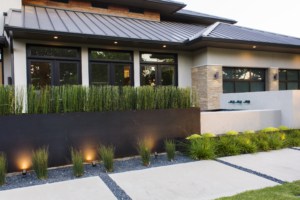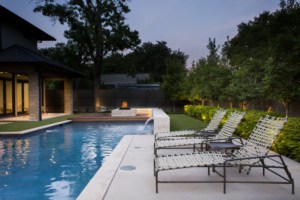We all look great with good lighting and it’s the same when plants, doorways, and walkways are lit, exposing their beauty and the path to take.
Besides making them look inviting, lighted doorways and walkways enhance the safety of your property. Discover tips and outdoor lighting ideas that will enhance the ambiance and security of your Texas home!
Types of Outdoor Lighting
There are three types of outdoor lighting: task, ambient, and accent.

Task
Task lighting illuminates walkways and doors, helping avoid falls. It is especially beneficial around outdoor grills and other cooking or play areas. When installing task lights, be mindful of where shadows fall and consider lighting steps to and from your porch, deck, or pool. Additionally, consider motion-activated lights at entrance areas like garage doors to conserve energy (Bonus points for also preventing stray wildlife).
Ambient
Ambient lighting creates a mood. Turn your Texas home into a relaxing area with soft lighting or jazz up the mood with colorful focal points for a festive party or the holidays.
Accent
Here’s your chance to shine a light on areas of your landscape that you want to enjoy. You can highlight the form, flowers, and foliage of an ornamental tree, such as a Texas mountain laurel or Texas redbud. Or cast light on the arrangement of plants in your front garden for your security and the enjoyment of passersby.
Accent lighting can enhance the architectural details of your home, such as ornamentation, surface, or façade. Lighting landscape art, from an ornate trellis to a pond, metal sculpture, or stone marking, can take center stage in your night garden.
Outdoor Lighting Fixtures
Your outdoor light fixtures should express your style or match the architecture of your home. This is especially true for fixtures that will be highly visible, such as porch or garage lights. Mission, mid-century modern, classic, rustic, and contemporary fixtures are just a few styles available.
Make sure your fixtures are rated for exterior use. Damp-rated fixtures work well in covered areas, where they are not exposed directly to the elements. And wet-location or wet-rated is a better fit for braving the weather. If the fixtures will be in areas that could flood, such as a pool area, consider marine-rated lighting.


Path Lights
These lights are usually smaller with downward-directed illumination for safety. Space path lights along walkways or driveways or use them to define spaces.
Wall Lights
Porch lights are a common example of wall lights. Usually, wall lights are ornamental and add to the ambiance of the setting.
Post Lights
Lamp posts mark entryways, such as where your driveway meets the road. Shorter versions can also identify the beginning of a pathway or guide people along the way.
Step or Deck Lights
These types of lights are installed into structures. They illuminate steps, cast light on walls, or define specific areas, such as seating or entertainment centers.
Landscape Lighting
Landscape lighting encompasses all of the lights on your property. It includes lights for pathways, accent plants, or art and can be used to illuminate certain spaces, such as a night garden, pond, or pool.
When designing your landscape plant, consider layers of lighting, landscape plants, and existing structures like pools or outdoor kitchens. For example, purchasing a home with a pool requires blending different types of outdoor lighting to create a dynamic, functional, and aesthetically pleasing outdoor space.
Timers and Sensors
Equip outdoor lights with timers or motion sensors to enhance security and conserve energy. Solar-powered lighting is also available but is efficient only when exposed to full sun.
Types of Lamps
LED (light-emitting diode) lamps are the most popular type of bulb used in outdoor lights. Although these may cost more upfront, they have a longer lifespan and conserve energy, saving you money in the long run.
LED lamps are engineered for various outdoor lighting applications and can be used with low- and line-voltage wiring. Line voltage is 120 volts like what you have indoors, while low voltage is 12 volts, uses less energy, and is usually easier to install
Planning Your Outdoor Lighting
Consider the scale and placement of fixtures. Ask yourself how far the light will shine and in which direction. Your outdoor lighting plan also includes light purpose and placement.
Visit lighting centers or home improvement stores to see what types of fixtures and lamps are available. Check out online lighting retailers or companies to see what’s in their inventory. Gather info on the cost of the fixtures to develop your budget.
Don’t forget to consider installation and electrical. Installation and wiring costs also are part of your project’s costs. Get more than one estimate and check out reviews of companies you are considering.
You don’t have to light up your whole landscape all at once. If all of this seems overwhelming, start with LED string lights or tabletop battery candles. Then begin work on your front porch, patio, or deck. Expand your landscape lighting as your budget and time allow to illuminate flower gardens, art, or other attributes of your landscape.
To combine function, security, and ambiance, reach out to an outdoor landscaping professional to help you design the outdoor space of your dreams.